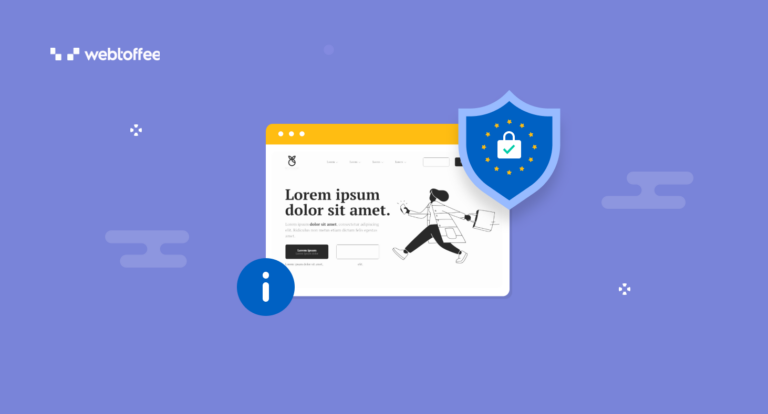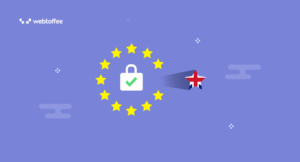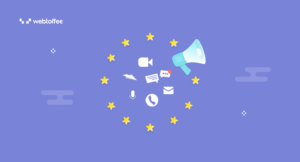EU’s General Data Protection Regulation (GDPR) regulates businesses from collecting personally identifiable information from their customers. If you are doing business with EU citizens, it is crucial that you properly understand the concept of personally identifiable information (PII).
Personally identifiable information is highly sensitive data that includes information about an individual that can be used to identify and track the individual in person. Companies collecting the sensitive personal data of customers should ensure the safety and security of the data they collect.
Explore this article to find out what is personally identifiable information, how to securely manage customers’ personal data, and ensure compliance with GDPR guidelines.
So let’s get started.

Personally Identifiable Information (PII) refers to any data or information that can be used to identify an individual uniquely. It includes a range of identifiers, both direct and indirect, that can be linked to a specific person.
Examples: Names, Addresses, Social Security Numbers, Email addresses, Phone Numbers, and Biometric data.
We can classify PII into two: Direct identifiers and Quasi identifiers. The main difference between these two personal identifiers is how helpful they are for data analytics. Let’s explore further to understand the two types of PII.
Direct Identifiers
Direct identifiers are those identifiers that can be used to directly identify an individual. Examples: Name, Email Address, Credit Card number, Social Security number, etc.
Usually, direct identifiers are unique to an individual, and can identify them easily without additional information. However, there are instances where a single direct identifier may not be sufficient to identify someone.
For example, if someone has a common name like Thomas Wilson, merely knowing the name might not be enough. In such cases it requires additional information to identify the individual.
Quasi Identifiers or Indirect Identifiers
Quasi identifiers, also known as indirect identifiers, are pieces of information that can be combined with other data to identify an individual.
Examples: Date of birth, Zip code, Gender, Occupation, Marital status, etc.
Indirect personal identifiers usually don’t identify an individual but can be used with direct identifiers to find additional information about the individual.
Here is a comprehensive list of Personally Identifiable Information of an individual:
Personal Identifiers:
- Name (Full name, including middle names)
- Alias or username
- Nickname
- Date of birth
- Age
Contact Information:
- Address (Residential, business, or email)
- Phone numbers (Mobile, landline)
- Email addresses
Government-issued Identifiers:
- Social Security Number (SSN)
- Passport number
- Driver’s license number
- National identification number
Biometric Data:
- Fingerprints
- Retina scans
- Facial recognition data
Financial Information:
- Credit card numbers
- Bank account details
- Financial transaction records
Demographic Information:
- Race or ethnicity
- Gender
- Sexual orientation
Health-related Information:
- Medical records
- Health insurance information
- Genetic information
Employment Information:
- Employment history
- Employee ID numbers
- Salary information
Education Information:
- School records
- Educational qualifications
- Student ID numbers
Online Identifiers:
- IP addresses
- Usernames
- Social media handles
Device Information:
- MAC addresses
- Device serial numbers
Location Data:
- GPS coordinates
- Location History
Criminal Records:
- Criminal history
- Arrest records
Vehicle Information:
- Vehicle registration details
- Driver’s license plate number
Personally identifiable information can include sensitive information about a person that can pose a risk to an individual’s privacy and security. Here are some reasons why you should protect the PII of your customers.
- Preventing Identity Theft
Personally identifiable information is a prime target of identity thieves. They can potentially use this information to create fake accounts on social media websites and/or engage in criminal activities such as honey trapping, social engineering attacks, cyberbullying, etc.
- Preventing Financial Fraud
PII includes credit card numbers and social security numbers that are linked to financial transactions. This information can be used for financial fraud, including unauthorized money transactions from individuals. So, protecting PII is essential for maintaining financial security, preventing unauthorized access to accounts, and avoiding fraudulent financial activities.
- Responsible Data Handling
Unauthorized access or misuse of PII can infringe upon personal space and compromise the confidentiality of your customers. So, if you are collecting the personal information of your customers, it is your responsibility to ensure the secure handling of their information and respect their privacy rights.
- Legal and Regulatory Compliance
Many data protection regulations have explicitly mentioned protecting the personally identifiable information of customers. If you have failed to comply with these regulations, you will have to face huge penalties and fines.
- Building Trust and Reputation
Having a privacy-focused approach for your business will build trust with your customers. A reputation for strong data security practices enhances customer confidence and loyalty.
Also Read: Privacy in the Age of Digital Surveillance
GDPR defines PII or Personal data as any related to an identified or identifiable natural person (data subject). This definition includes various forms of information, such as Names, identification numbers, location data, online identifiers (such as IP addresses and cookies), etc. GDPR aims to regulate the processing of this personal data to protect the rights and privacy of individuals within the European Union (EU).
The law outlines various principles that organizations should follow when processing personal data. These principles include lawfulness, fairness, transparency, purpose limitation, data minimization, data accuracy, storage limitation, confidentiality, and accountability.
What Are Users’ Rights for PII Under GDPR?
GDPR explicitly outlines eight fundamental rights for individuals referred to as data subjects.
- Right to Information:
Data subjects have the right to be informed about the collection, processing, and purposes of their data. This includes information about who processes the data, why it is processed, and where and how it is processed.
- Right to Access:
Individuals have the right to access the personal data held by data controllers. This empowers data subjects to be aware of who has access to their data and the duration for which it will be retained.
- Right to Object:
GDPR grants data subjects the right to object to the collection or processing of their data, particularly for purposes deemed unnecessary, such as marketing. Users can withdraw consent for the collection of personal data.
- Right to Erasure (Right to Be Forgotten):
This right allows users to request the deletion of their personal data if it is no longer required for its original purpose. Individuals can request the removal of their data from a company’s database or system.
- Right to Rectification:
Data subjects have the right to correct their personal data, ensuring its accuracy and keeping it up-to-date.
- Right to Data Portability:
Users are granted the right to receive their personal data in a structured, organized, and machine-readable format. This facilitates the transfer or copying of data from one platform to another.
- Right to Restriction of Processing:
GDPR allows users to restrict the processing of their personal data in specific circumstances, such as when the data is inaccurate, the processing is unlawful, or the data is no longer needed for its original purpose.
- Right Not to Be Subject to Automated Decision-Making:
Individuals have the right not to be subjected to decisions based solely on automated processing, including profiling if such decisions have legal or similarly significant consequences.
How to Comply With GDPR for Processing PII?
Follow the below guidelines to ensure compliance with the General Data Protection Regulation for processing personally identifiable information:
- Understand the regulations, definitions, rights and responsibilities, principles, etc.
- Identify the collection and processing of PII within your company, including the sources, purpose, and recipients of the data.
- Establish a legal basis for processing the PII of your customers or clients.
- Obtain prior consent from users for processing their data and allow them to modify the consent anytime.
- Implement the Privacy by Design (PbD) framework for your business.
- Implement proper security measures to protect the data from unauthorized access.
- Inform individuals about their rights regarding their PII. Establish procedures to facilitate the exercise of data subject rights, including access, rectification, erasure, objection, and data portability.
- Conduct Data Protection Impact Assessments (DPIAs) regularly to find potential risks.
- Keep records of data processing activities and compliance efforts.
- Develop and implement a data breach response plan. Report any PII breaches to the relevant supervisory authority and, when necessary, to affected individuals.
- If using third-party processors, ensure that they comply with the GDPR.
- Appoint a Data Protection Officer (DPO) if your business handles a bulk amount of PII from your clients or customers.
- Give proper training to your staff on GDPR principles and ensure they are aware of their roles and responsibilities in protecting PII.
- Stay informed about changes in GDPR regulations and guidelines related to the processing of PII.
- Seek legal advice to ensure that your data processing practices comply with GDPR and any applicable national data protection laws.
Wrapping Up
Understanding the sensitivity of Personally Identifiable Information is crucial, especially for businesses engaging with EU citizens. This article underscores the significance of protecting PII to prevent identity theft and financial fraud and maintain responsible data handling for businesses.
We believe that we have covered everything in this article that you should know about PII and GDPR compliance. If you have any questions, drop them in the comments section; we’d be happy to help you.
Thanks for reading!
Disclaimer: This article was intended for informational purposes only and does not represent legal advice. We have no intention of obtaining any kind of attorney-client relationship. If you are looking for legal advice, we recommend you contact a professional.



